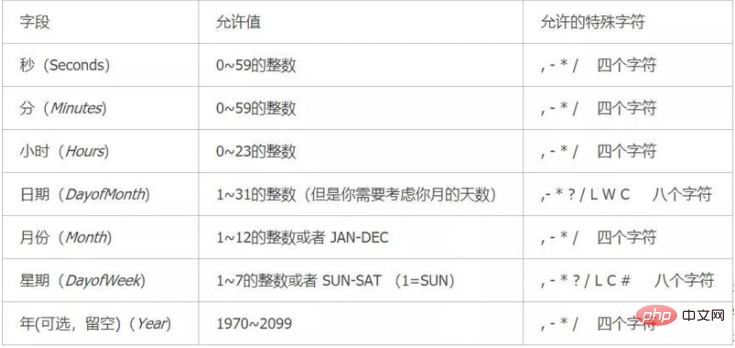java基础教程介绍定时任务在实际的开发

推荐(免费):java基础教程
日子匆匆穿过我而行,奔向海洋。
定时任务在实际的开发中特别常见,比如电商平台 30 分钟后自动取消未支付的订单,以及凌晨的数据汇总和备份等,都需要借助定时任务来实现,那么我们本文就来看一下定时任务最简单的几种实现方式。
TOP 1:Timer
Timer 是 JDK 自带的定时任务执行类,无论任何项目都可以直接使用 Timer 来实现定时任务,所以 Timer 的优点就是使用方便,它的实现代码如下:
public class MyTimerTask {
public static void main(String[] args) {
// 定义一个任务
TimerTask timerTask = new TimerTask() {
@Override
public void run() {
System.out.println("Run timerTask:" + new Date());
}
};
// 计时器
Timer timer = new Timer();
// 添加执行任务(延迟 1s 执行,每 3s 执行一次)
timer.schedule(timerTask, 1000, 3000);
}
}程序执行结果如下:
Run timerTask:Mon Aug 17 21:29:25 CST 2020 Run timerTask:Mon Aug 17 21:29:28 CST 2020 Run timerTask:Mon Aug 17 21:29:31 CST 2020
Timer 缺点分析
Timer 类实现定时任务虽然方便,但在使用时需要注意以下问题。
当一个任务的执行时间过长时,会影响其他任务的调度,如下代码所示:
public class MyTimerTask {
public static void main(String[] args) {
// 定义任务 1
TimerTask timerTask = new TimerTask() {
@Override
public void run() {
System.out.println("进入 timerTask 1:" + new Date());
try {
// 休眠 5 秒
TimeUnit.SECONDS.sleep(5);
} catch (InterruptedException e) {
e.printStackTrace();
}
System.out.println("Run timerTask 1:" + new Date());
}
};
// 定义任务 2
TimerTask timerTask2 = new TimerTask() {
@Override
public void run() {
System.out.println("Run timerTask 2:" + new Date());
}
};
// 计时器
Timer timer = new Timer();
// 添加执行任务(延迟 1s 执行,每 3s 执行一次)
timer.schedule(timerTask, 1000, 3000);
timer.schedule(timerTask2, 1000, 3000);
}
}程序执行结果如下:
进入 timerTask 1:Mon Aug 17 21:44:08 CST 2020 Run timerTask 1:Mon Aug 17 21:44:13 CST 2020 Run timerTask 2:Mon Aug 17 21:44:13 CST 2020 进入 timerTask 1:Mon Aug 17 21:44:13 CST 2020 Run timerTask 1:Mon Aug 17 21:44:18 CST 2020 进入 timerTask 1:Mon Aug 17 21:44:18 CST 2020 Run timerTask 1:Mon Aug 17 21:44:23 CST 2020 Run timerTask 2:Mon Aug 17 21:44:23 CST 2020 进入 timerTask 1:Mon Aug 17 21:44:23 CST 2020
从上述结果中可以看出,当任务 1 运行时间超过设定的间隔时间时,任务 2 也会延迟执行。 原本任务 1 和任务 2 的执行时间间隔都是 3s,但因为任务 1 执行了 5s,因此任务 2 的执行时间间隔也变成了 10s(和原定时间不符)。
使用 Timer 类实现定时任务时,当一个任务抛出异常,其他任务也会终止运行,如下代码所示:
public class MyTimerTask {
public static void main(String[] args) {
// 定义任务 1
TimerTask timerTask = new TimerTask() {
@Override
public void run() {
System.out.println("进入 timerTask 1:" + new Date());
// 模拟异常
int num = 8 / 0;
System.out.println("Run timerTask 1:" + new Date());
}
};
// 定义任务 2
TimerTask timerTask2 = new TimerTask() {
@Override
public void run() {
System.out.println("Run timerTask 2:" + new Date());
}
};
// 计时器
Timer timer = new Timer();
// 添加执行任务(延迟 1s 执行,每 3s 执行一次)
timer.schedule(timerTask, 1000, 3000);
timer.schedule(timerTask2, 1000, 3000);
}
}程序执行结果如下:
进入 timerTask 1:Mon Aug 17 22:02:37 CST 2020 Exception in thread "Timer-0" java.lang.ArithmeticException: / by zero at com.example.MyTimerTask$1.run(MyTimerTask.java:21) at java.util.TimerThread.mainLoop(Timer.java:555) at java.util.TimerThread.run(Timer.java:505) Process finished with exit code 0
Timer 小结
Timer 类实现定时任务的优点是方便,因为它是 JDK 自定的定时任务,但缺点是任务如果执行时间太长或者是任务执行异常,会影响其他任务调度,所以在生产环境下建议谨慎使用。
TOP 2:ScheduledExecutorService
ScheduledExecutorService 也是 JDK 1.5 自带的 API,我们可以使用它来实现定时任务的功能,也就是说 ScheduledExecutorService 可以实现 Timer 类具备的所有功能,并且它可以解决了 Timer 类存在的所有问题。
ScheduledExecutorService 实现定时任务的代码示例如下:
public class MyScheduledExecutorService {
public static void main(String[] args) {
// 创建任务队列
ScheduledExecutorService scheduledExecutorService =
Executors.newScheduledThreadPool(10); // 10 为线程数量
// 执行任务
scheduledExecutorService.scheduleAtFixedRate(() -> {
System.out.println("Run Schedule:" + new Date());
}, 1, 3, TimeUnit.SECONDS); // 1s 后开始执行,每 3s 执行一次
}
}程序执行结果如下:
Run Schedule:Mon Aug 17 21:44:23 CST 2020 Run Schedule:Mon Aug 17 21:44:26 CST 2020 Run Schedule:Mon Aug 17 21:44:29 CST 2020
ScheduledExecutorService 可靠性测试
ScheduledExecutorService 可以解决 Timer 任务之间相应影响的缺点,首先我们来测试一个任务执行时间过长,会不会对其他任务造成影响,测试代码如下:
public class MyScheduledExecutorService {
public static void main(String[] args) {
// 创建任务队列
ScheduledExecutorService scheduledExecutorService =
Executors.newScheduledThreadPool(10);
// 执行任务 1
scheduledExecutorService.scheduleAtFixedRate(() -> {
System.out.println("进入 Schedule:" + new Date());
try {
// 休眠 5 秒
TimeUnit.SECONDS.sleep(5);
} catch (InterruptedException e) {
e.printStackTrace();
}
System.out.println("Run Schedule:" + new Date());
}, 1, 3, TimeUnit.SECONDS); // 1s 后开始执行,每 3s 执行一次
// 执行任务 2
scheduledExecutorService.scheduleAtFixedRate(() -> {
System.out.println("Run Schedule2:" + new Date());
}, 1, 3, TimeUnit.SECONDS); // 1s 后开始执行,每 3s 执行一次
}
}程序执行结果如下:
Run Schedule2:Mon Aug 17 11:27:55 CST 2020 进入 Schedule:Mon Aug 17 11:27:55 CST 2020 Run Schedule2:Mon Aug 17 11:27:58 CST 2020 Run Schedule:Mon Aug 17 11:28:00 CST 2020 进入 Schedule:Mon Aug 17 11:28:00 CST 2020 Run Schedule2:Mon Aug 17 11:28:01 CST 2020 Run Schedule2:Mon Aug 17 11:28:04 CST 2020
从上述结果可以看出,当任务 1 执行时间 5s 超过了执行频率 3s 时,并没有影响任务 2 的正常执行,因此使用 ScheduledExecutorService 可以避免任务执行时间过长对其他任务造成的影响。
接下来我们来测试一下 ScheduledExecutorService 在一个任务异常时,是否会对其他任务造成影响,测试代码如下:
public class MyScheduledExecutorService {
public static void main(String[] args) {
// 创建任务队列
ScheduledExecutorService scheduledExecutorService =
Executors.newScheduledThreadPool(10);
// 执行任务 1
scheduledExecutorService.scheduleAtFixedRate(() -> {
System.out.println("进入 Schedule:" + new Date());
// 模拟异常
int num = 8 / 0;
System.out.println("Run Schedule:" + new Date());
}, 1, 3, TimeUnit.SECONDS); // 1s 后开始执行,每 3s 执行一次
// 执行任务 2
scheduledExecutorService.scheduleAtFixedRate(() -> {
System.out.println("Run Schedule2:" + new Date());
}, 1, 3, TimeUnit.SECONDS); // 1s 后开始执行,每 3s 执行一次
}
}程序执行结果如下:
进入 Schedule:Mon Aug 17 22:17:37 CST 2020 Run Schedule2:Mon Aug 17 22:17:37 CST 2020 Run Schedule2:Mon Aug 17 22:17:40 CST 2020 Run Schedule2:Mon Aug 17 22:17:43 CST 2020
从上述结果可以看出,当任务 1 出现异常时,并不会影响任务 2 的执行。
在单机生产环境下建议使用 ScheduledExecutorService 来执行定时任务,它是 JDK 1.5 之后自带的 API,因此使用起来也比较方便,并且使用 ScheduledExecutorService 来执行任务,不会造成任务间的相互影响。
TOP 3:Spring Task
如果使用的是 Spring 或 Spring Boot 框架,可以直接使用 Spring Framework 自带的定时任务,使用上面两种定时任务的实现方式,很难实现设定了具体时间的定时任务,比如当我们需要每周五来执行某项任务时,但如果使用 Spring Task 就可轻松的实现此需求。
以 Spring Boot 为例,实现定时任务只需两步:
具体实现步骤如下。
① 开启定时任务
开启定时任务只需要在 Spring Boot 的启动类上声明 @EnableScheduling 即可,实现代码如下:
@SpringBootApplication
@EnableScheduling // 开启定时任务
public class DemoApplication {
// do someing
}② 添加定时任务
定时任务的添加只需要使用 @Scheduled 注解标注即可,如果有多个定时任务可以创建多个 @Scheduled 注解标注的方法,示例代码如下:
import org.springframework.scheduling.annotation.Scheduled;
import org.springframework.stereotype.Component;
@Component // 把此类托管给 Spring,不能省略
public class TaskUtils {
// 添加定时任务
@Scheduled(cron = "59 59 23 0 0 5") // cron 表达式,每周五 23:59:59 执行
public void doTask(){
System.out.println("我是定时任务~");
}
}注意:定时任务是自动触发的无需手动干预,也就是说 Spring Boot 启动后会自动加载并执行定时任务。
Cron 表达式
Spring Task 的实现需要使用 cron 表达式来声明执行的频率和规则,cron 表达式是由 6 位或者 7 位组成的(最后一位可以省略),每位之间以空格分隔,每位从左到右代表的含义如下:
其中 * 和 ? 号都表示匹配所有的时间。

cron 表达式在线生成地址:https://cron.qqe2.com/
The above is the detailed content of Introducing the three simplest implementation methods of Java scheduled tasks. For more information, please follow other related articles on the PHP Chinese website!